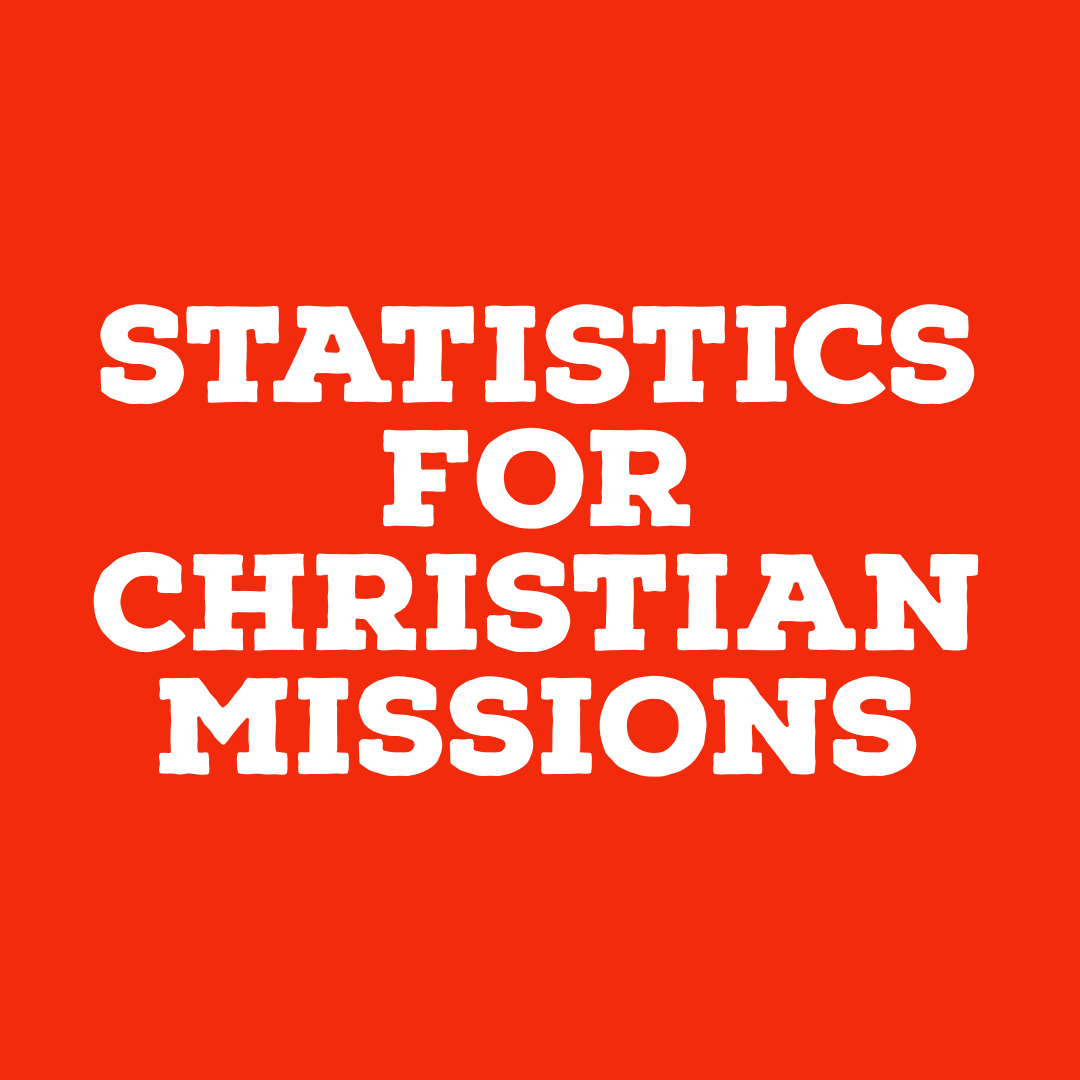“Digital Missions STATISTICs” - Download
MISSION STATISTICS
There are 7.83 billion people in the world. - 17,440 people groups (Joshua Project Progress 2022)
22.8% significantly reached people groups (1,781,535,000 people, 3,284 people groups, >10% evangelicals) (Joshua Project Progress 2022)
24.9% partially reached people groups (1,952,428,000people, 3,793 people groups, Evangelicals > 2% and <= 10% (Joshua Project Progress 2022)
6.9% superficially reached (538,339,000 people, 1,815 people groups, Evangelicals <= 2%, Professing Christians > 50%, (Joshua Project Progress 2022)
3.3% minimally reached (259,900,000 people, 1,134 people groups, Evangelicals <= 2%, Professing Christians > 5% and <= 50%) (Joshua Project Progress 2022)
42.1% unreached (3,296,866,000 people, 7,414 people groups, Evangelicals <= 2%, Professing Christians <= 5%) (Joshua Project Progress 2022)
% Christian = 32.3%, % Evangelical = 7.9% (Operation World 2022)
2.43 billion are Christian (748 million are Evangelical Christian) (Joshua Project Religions 2022)
1.9 billion are Muslim. (Joshua Project Religions 2022)
1.19 billion are Hindu. (Joshua Project Religions 2022)
1.01 billion are Non-Religious. (Joshua Project Religions 2022)
501 million are Buddhist. (Joshua Project Religions 2022)
730 million are of Ethnic Religions including Chinese Religion. (Joshua Project Religions 2022)59 mission are of other religions (Joshua Project Religions 2022)
8 million other/unknown. (Joshua Project Religions 2022)
There are 6,800 languages in the world. (Joshua Project)
Some 65-70% of the world's population live in religiously restrictive countries. (Joshua Project People Groups 2022)
11,421 people groups have the Jesus Film in their primary language, totaling 7,299,000,000 individuals. (Joshua Project People Groups 2022)
64 nations – about one-third of the countries in the world – have high or very high restrictions on religion. But because some of the most restrictive countries are very populous, nearly 70 percent of the world’s 6.8 billion people live in countries with high restrictions on religion, the brunt of which often falls on religious minorities (Pew Research Global Restrictions on Religion 2009/2020)
Some restrictions result from government actions, policies and laws. Others result from hostile acts by private individuals, organizations and social groups. (Pew Research Global Restrictions on Religion 2009/2020)
Scripture Reading
Evangelical Protestant - 63% once a week, 12% 1 or 2 a month, 7% several times a year, 18% seldom/never (Pew Research Scripture Reading 2014)
Historically Black Protestant - 61% once a week, 13% 1 or 2 a month, 8% several times a year, 18% seldom/never (Pew Research Scripture Reading 2014)
Mainline Protestant - 30% once a week, 13% 1 or 2 a month, 12% several times a year, 44% seldom/never (Pew Research Scripture Reading 2014)
Religious Service Attendance
Evangelical Protestant - 58% once a week, 30% 1 or 2 a month, 12% seldom/never (Pew Research Attendance at Religious Services 2014)
Historically Black Protestant - 53% once a week, 36% 1 or 2 a month, 10% seldom/never (Pew Research Attendance at Religious Services 2014)
Mainline Protestant - 33% once a week, 43% 1 or 2 a month, 24% seldom/never (Pew Research Attendance at Religious Services 2014)
86% of all unreached people groups lie within the region called the 10/40 window, which is between 10 and 40 degrees north and from the west coast of Africa to the east coast of Asia. (Joshua Project)
In AD 100 there were 360 people for every believer. Now there are 7.3 people for every believer.
(Winter et al., 1)90% of foreign missionaries work among already reached people groups. 10% work among unreached people groups. (Winter and Koch, 543)
Despite Christ's command to evangelize, 67% of all humans from AD 30 to the present day have never even heard the name of Jesus Christ. (Baxter 2007, 12)
91% of all Christian outreach/evangelism does not target non-Christians, but targets other Christians. (Baxter 2007, 12)
In the last 40 years, over 1 billion people have died who have never heard of Jesus, and around 30 million people this year will perish without hearing the message of salvation. (Baxter 2007, 12)
70,000+ people die everyday in the unreached world without Jesus. (Baxter 2007, 12)
Of foreign mission funding: 87% goes for work among those already Christian. 12% for work among already evangelized, but Non-Christian. 1% for work among the unevangelized and unreached people.
(Baxter 2007, 12)Christians make up 33% of the world's population, but receive 53% of the world's annual income and spend 98% of it on themselves. (Barrett and Johnson 2001, 656)
Only .1% of all Christian giving is directed toward mission efforts in the 38 most unevangelized countries in the world. (Barrett and Johnson 2001, 656)
22 million internationals visit the US each year. Of these, some 630,000 are university students from 220 countries, 25% of which prohibit Christian missionaries. 80% of those students will return to their countries having never been invited to an American home. (The Traveling Team)
American Christians spend 95% of offerings on home-based ministry, 4.5% on cross-cultural efforts in already reached people groups, and .5% to reach the unreached. (The Traveling Team)
There are 430,000 missionaries from all branches of Christendom. Only between 2 and 3% of these missionaries work among unreached peoples. (The Traveling Team)
There are 140,000 recorded protestant missionaries serving in the world, with 64,000 from the US. (The Traveling Team)
Of the 140,000 Protestant missionaries, 74% work among nominal Christians, 8% among tribal peoples, 6% Muslims, 4% Non-religious/atheists, 3% among Buddhists, 2% Hindus, 1% Jews. (The Traveling Team)
MISSIONARIES PER RELIGION: (The Traveling Team)
Tribals – 714,108,000 population with 11,900 Missionaries: 1 for every 60,000
Hindus – 984,532,000 population with 5,500 Missionaries: 1 for every 179,000
Unreligious – 831,267,000 population with 11,700 Missionaries: 1 for every 71,000
Muslims – 1,703,146,000 population with 4,200 Missionaries: 1 for every 405,500
Buddhists – 520,002,000 population with 2,000 Missionaries: 1 for every 260,000
Christians' annual income is $12.3 trillion. $213 billion is given to Christian causes. $11.4 billion is given to foreign missions, 87% of which goes to work being done among the already Christian, 12% goes to work among the evangelized non-Christians, 1% among the unevangelized. (The Traveling Team)
Over 160,000 believers will be martyred this year. (The Traveling Team)
The total cost of Christian outreach averages $330,000 for each and every newly baptized person. (World Evangelization Research Center)
54% of evangelical Christians are non-whites. (World Evangelization Research Center)
The country with the fastest Christian expansion ever is China, now at 10,000 new converts every day. (World Evangelization Research Center)
It costs Christians 700 times more money to baptize converts in rich Christian countries, such as Switzerland, than in poor unevangelized countries, such as Nepal. (World Evangelization Research Center)
US ministries send out over 144,000 short-term missionaries each year. (Weber and Welliver 2007, 13)
US mission agencies have an annual budget of over $5.2 billion. (Weber and Welliver 2007, 13)
The average American Christian gives only 1 penny a day to global missions. (Yohannan, Revolution in World Missions, 142)
86 countries prohibit or restrict Western missionaries. (Yohannan, Come Let's Reach the World, 31)
Christian organizations spend $8 billion a year on conferences. (Yohannan, Come Let's Reach the World, 126)
Indigenous missionaries do 90% of pioneer mission work, but only receive 10% of mission funding. Meanwhile foreign missionaries do 10% of pioneer mission work, but receive 90% of mission funding. (Finley 2004, 178 & 244)
Two of the largest Gospel radio broadcasters, Far East Broadcasting Company and Gospel for Asia, both receive around 1,000,000 listener responses each year. (Far East Broadcasting Company, 15; Gospel for Asia)
There have been 4.1 billion viewings of the Jesus Film, representing about 3 billion individuals. More than 99% of the world's population could view the film in a language they know. (Johnstone and Mandryk 2005, 7)
MISSIONS STATISTICS REFERENCES
Barrett, David B., and Todd M. Johnson. 2001. World Christian Trends AD 30 - AD 2200: Interpreting the annual Christian Megacensus. Associate ed. Christopher R. Guidry and Peter F. Crossing. Pasadena, CA: William Carey Library.
Baxter, Mark R. 2007. The Coming Revolution: Because Status Quo Missions Won't Finish the Job. Mustang, OK: Tate Publishing.
Chacko, Jossy. 2008. Madness. Croydon, Australia: Empart.
Far East Broadcasting Company. FEBC 2010-2011 Gift Catalog.
Finley, Bob. 2005. Reformation in Foreign Missions. USA: Xulon Press.
Global Media Outreach. About Us. http://www.globalmediaoutreach.com/about_us.html .
Gospel for Asia. Reach Millions with your Radio Ministry. http://www.gfa.org/radio/radio-impact/.
Johnstone, Patrick, and Jason Mandryk. 2005. Operation World. Tyrone, GA: Authentic Media.
Joshua Project. http://www.joshuaproject.net/.
Libby, Lauren. 2010. President's Column. 2010 Annual Ministry Progress Report 31, no. 2,
http://www.twr.org/resources/progress_report.html.Pew Research Center. 2009. “Global Restrictions on Religion.” Pew Research, July 12, 2009. https://www.pewresearch.org/wp-content/uploads/sites/7/2009/12/restrictions-fullreport1.pdf.
Pew Research Center. 2014. “Attendance at Religious Services.” Pew Research, 2014. https://www.pewforum.org/religious-landscape-study/attendance-at-religious-services/.
Pew Research Center. 2014. “Frequency of Reading Scripture.” Pew Research, 2014. https://www.pewforum.org/religious-landscape-study/frequency-of-reading-scripture/.
Pew Research Center. 2020. “How COVID-19 Restrictions Affected Religious Groups Around the World in 2020” https://www.pewresearch.org/religion/2022/11/29/how-covid-19-restrictions-affected-religious-groups-around-the-world-in-2020/
The Traveling Team. State of the World. http://www.thetravelingteam.org/stateworld.
Weber, Linda J., and Dotsey Welliver, ed. 2007. Mission Handbook 2007-2009: U.S. and Canadian Protestant Ministries Overseas. Wheaton, IL: Evangelism and Missions Information Service.
Winter, Ralph D., and Bruce A. Koch. 2009. Finishing the Task: The Unreached Peoples Challenge. In Perspectives on the World Christian Movement: A Reader, ed. Ralph D. Winter and Steven C. Hawthorne, 531-46. Pasadena, CA: William Carey Library.
Winter, Ralph D., Phil Bogosian, Larry Boggan, Frank Markow, and Wendell Hyde. The Amazing Countdown Facts. Pasadena, CA: US Center for World Mission. http://www.uscwm.org/uploads/pdf/adoptapeople/amazingcountdown.pdf.
World Evangelization Research Center. An AD 2001 Reality Check. http://gem-werc.org/gd/findings.htm.
Yohannan, K.P. 2004. Come Let's Reach the World. Carrollton, TX: GFA Books.
Yohannan, K.P. 2004. Revolution in World Missions. Carrollton, TX: GFA Books.












